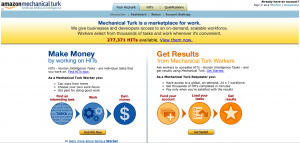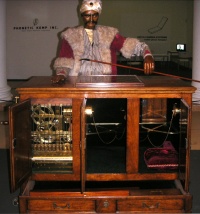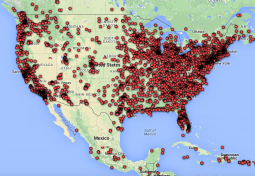Mechanical Turk
|
Contents
Etymology
The name Mechanical Turk comes from the 18th century chess-playing automaton, which was named "The Turk". The Turk was created by Wolfgang von Kempelen in 1770 in Austria. The machine appeared to be able to play a strong game of chess against any human opponent, even beating Napoleon Bonaparte and Benjamin Franklin on its tour of Europe [1]. It wasn't until the early 1820s that the Turk was exposed as an elaborate hoax. There machine was designed so a human chest master could sit hidden within the cabinet under the board and control the movements of the humanoid dummy [2]. The Turk machine is what inspired the name for Amazon's crowdsourcing tasks website. Just as the Turk needed the human chess master to properly function, MTurk provides opportunities for workers to perform tasks that modern machines are unable to complete.
History
Prior to its public launch, MTurk was created by Peter Cohen for use within the Amazon company. The original function of MTurk was to find duplicate webpages describing the same product on Amazon.com and to categorize all the the various product pages. Using software and algorithms to eliminate all duplicates across thousands of different data sets would be practically impossible. Amazon needed human intelligence to perform this daunting task, and more specifically, they needed a way to create a community of workers who could work together in parallel [3]. Peter Cohen, who was the director of Amazon Web Services during this time, led MTurk from idea to launch.
Peter quickly realized that many companies had daunting tasks that humans could do better than computers, thus deciding to make it a public marketplace. MTurk was launched publicly on November 2, 2005 as a place where businesses with work and people looking to do work could find each other.
By March of 2007, the MTurk workforce contained over 100,000 workers from over 100 countries. The site continued to grow exponentially and by January of 2011, there were over 500,000 workers from 190 different countries [4]
Originally, the Amazon MTurk service was launched as an API-only product platform. Amazon quickly realized that programmers and developers were not the only people who needed access to this on-demand, scalable workforce. Today, workers and requestors can visit the MTurk service via an internet website platform, API, and Command Line Tool.[3]
Description of Service
Users
There are two types of MTurk users: Workers (employees) and Requestors (employers).
Workers set their own hours and only complete the HITs that appeal to them. Because workers can complete and many or as little tasks as they choose, they are considered paid contractors, rather than paid employees, in the eye of the law. This caveat means that requestors do not have to file tax forms or pay payroll taxes, thus avoiding laws such as minimum wage, compensation, and overtime. Workers report their income as self-employment income when filing taxes. The average wage of an MTurk worker is about $1.00/hour, or approximately a few cents for each tasks.[5]
Requestors can post a large variety of HITs for workers to complete. Requestors can also have workers fill out questionnaires or complete tests to verify certain qualifications. If they feel that the task performed by a worker does not meet certain qualifications or standards, requestors can reject the work completed by the worker. In each description of the HIT, requestors much specify how much they are paying for each HIT, how many workers they want for each HIT, and how much time the worker will have to complete the HIT once they begin.
Uses
MTurk created a large platform where many people can work on the same task in parallel. The importance of MTurk is that is allows businesses and individuals to crowdsource work that is better done by a human rather than a computer. Below are some of the major categories of HITs that are posted on Mechanical Turk.
Processing photos/videos
It is very difficult for computers to analyze and process images, something that is an ideal task for MTurk workers. Typical photo processing HITs include:
- Label items found in a picture
- Audit images for inappropriate content
- Categorize and classify objects within images taken by satellites
Data cleaning/verification
Organizations with large online catalogues or databases can use Mechanical Turk to verify that the data is clean and there are no duplicates. Examples of these types of HITs include:
- Delete duplicate listings
- Verify details for various entires (i.e. phone numbers, addresses, etc.)
Information Collection
With Mechanical Turk, you can collect larges amount of data and information. For example, MTurk workers can:
- Search for information details in large documents
- Fill out surveys containing different types of data
- Write comments or blog entries for various websites
Data Processing
Mechanical Turk can be utilized to understand and intelligently respond to various types of data. Typical data processing HITs include:
- Editing and transcribing podcasts or other purely audio files
- Translating between languages for human purposes
- Classify accuracy of results generated by search engine queries
Ethical Implications
Mechanical Turk has received praise from technologists for its efficiency, activists for its ability to employ people in developing nations, and economists have praised MTurk for creating new ways for people to supplement their incomes. Wendy Kaufman claimed that Amazon Mechanical Turk has been "the biggest paradigm shift in innovation since the Industrial Revolution." [5]. Criticism of Mechanical Turk has focused on exploitation of workers in addition to fraud from employers.
Monetary Compensation
The average wage for a MTurk workers is $1.50 an hour [5]. Critics of MTurk claim that this low pay is exploiting workers, in some cases labeling it as a "digital sweat shop". Computer scientist Jaron Lanier has spoken out against MTurk, claiming that it takes advantage of workers and that the platform is designed to allow employers to think of workers as software components rather than humans, conjuring "a sense of magic, as if you can just play results out of the cloud at an incredibly low cost." [6] On the other hand, in one psychological study done by the University of Texas, evidence showed that many of the users did not complete the task for monetary compensation, rather they completed the work for enjoyment and self-fulfillment. [7]
Labor Relations
Because workers are paid as contractors rather than employees, requestors can avoid filing any paperwork, thus allowing them to bypass laws regarding minimum wage, overtime, workers compensation, and even taxes. Mechanical Turk does not require an application or exchange of information between workers and employers other than basic facts. Workers do not need to fill out tax forms and often the only "contract" is a clickwrap agreement: a quick page of fine print which an "accept" button at the bottom. With this lack of formality that is found in traditional work environments, the marketplace does not protect its workers. There is no ability for workers to negotiate with employers [5].
Fraud
If the completed HITs do not meet specific standards or certain qualifications determined by the requestor, the requestor can reject the work completed by the worker and not pay the worker any monetary compensation for their time. In an article published by The Nation magazine, many Turkers admitted that being scammed is a regular occurrence on MTurk: "Requesters get to keep the work product whether they officially 'accept' or 'reject' the work. As a result, many Turkers have complained of being denied payment through no fault of their own." [8]. Amazon does not resolve disputes between parties on MTurk and provides no warranties for the workers. Amazon is released from any liability as soon as the worker checks the "accept" box at the end of the clickwrap agreement. Because it is often impossible to know the identity of a certain requestor that scams a worker, workers cannot file complaints of unfair business practices with organizations such as the Better Business Bureau or the Federal Trade Commission.[8]
See Also
External Links
www.mturk.com
References
- ↑ SCHAFFER, Simon (1999), "Enlightened Automata", in Clark et al. (Eds), The Sciences in Enlightened Europe, Chicago and London, The University of Chicago Press, pp. 126-165.
- ↑ Ricky Jay, "The Automaton Chess Player, the Invisible Girl, and the Telephone", Jay's Journal of Anomalies, vol. 4 no. 4, 2000
- ↑ 3.0 3.1 What is the story behind the creation of Amazon's Mechanical Turk? Natalia Menezes, Quora, March 10, 2013, https://www.quora.com/What-is-the-story-behind-the-creation-of-Amazons-Mechanical-Turk
- ↑ MTurk CENSUS: About how many workers were on Mechanical Turk in 2010?, "biqcatherine" Amazon Web Services Discussion Forum, January 24, 2011, https://forums.aws.amazon.com/thread.jspa?threadID=58891
- ↑ 5.0 5.1 5.2 5.3 Amazon Mechanical Turk: The Digital Sweatshop, Ellen Cushing, East Bay Express, January/February 2013, http://www.utne.com/science-and-technology/amazon-mechanical-turk-zm0z13jfzlin.aspx
- ↑ Jaron Lanier (2013). Who Owns the Future?. Simon and Schuster. ISBN 978-1-4516-5497-4.
- ↑ http://pps.sagepub.com/content/6/1/3.short
- ↑ 8.0 8.1 How Crowdworkers Became the Ghosts in the Digital Machine, Moshe Marvit, The Nation, February 4, 2015, http://www.thenation.com/article/how-crowdworkers-became-ghosts-digital-machine/




